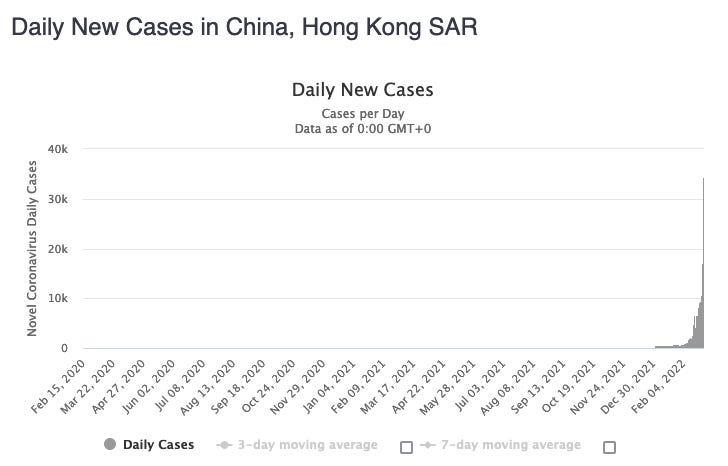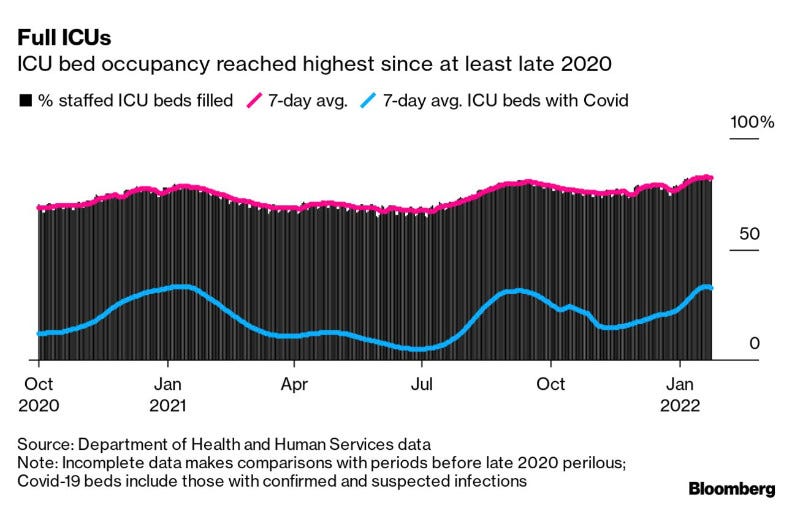This is the fourth in a multi part series that began here.
It would be difficult to blame the public health doctors in Hong Kong for thinking the pandemic was nearly over and they had won. Four waves of virus variants had been turned back by tight social distancing rules and aggressive contact tracing. Through much of 2021, the city recorded zero cases. Some 84 percent of people over age 11 had been vaccinated. In a city of 7.5 million people, most packed tightly together in tiny apartments, 36 million tests were administered. Hong Kong was winning the battle. Then the virus found a crack, and entered.
Two contagious local flight attendants returned from abroad in December and went unnoticed. A woman returning from Pakistan was infected while in hotel quarantine. The woman passed the virus to her husband, who spread it to a housecleaner who spread it to the very large housing development where she lived. More than 100 people there tested positive. By then it was too late to stop. It had spread to more than 20 senior centers. Omicron was loose in Hong Kong.
The New York Times warned February 16 that by this summer Omicron will have killed more than four times the number that have died of Covid in Hong Kong since the start of the pandemic. That is likely to be a significant underestimate. At this writing Hong Kong has 195,274 active cases and is averaging 135 deaths per day.
What this demonstrates is that no one is safe until everyone is safe. Cities are porous. Countries are porous. A flurry of new studies suggests that several parts of the immune system can mount a sustained, potent response to any coronavirus variant if a person has been vaccinated, yet many resist vaccines and many more cannot get them. The digital age has given all of us shorter attention spans. We are easily bored. Two years is enough for this pandemic. Let’s move on. But viruses, like Mother Nature, operate on their own timetable.
Modelers estimate that each Omicron-positive New Zealander is infecting an average of 4.64 other people — the highest rate among 180 countries analyzed. Experts believe that half the country could be infected within three months.
“We’re finally experiencing the difficult side of exponential growth,” said Dr. Wiles, the University of Auckland microbiologist. “I feel quite nervous about the rest of the year.”
We should study history more diligently. A Russian flu in the late 1800s is said to have led to loss of taste and smell. The elderly seemed to be at higher risk but children were spared. We don’t know anything else about the virus because this flu came before our ability to preserve specimens.
The first case of SARS-CoV-2, arising in China, although not reported to WHO until December 31, 2019, was likely on November 17, but there is evidence CoV-2 was circulating in France in late December in airport workers, and in sewage in Northern Italy in early December. In any respiratory virus with a rapid transmission rate—R(0) value—it’s going to be widespread by the time you actually detect it. The spread from Hubei province to Western Europe may have taken months to years in earlier centuries, which is why the Russian flu never got far. Today a virus can travel the world in hours.
In 1960 a common cold virus was isolated from mucus and an electron-micrograph showed protrusions or “spikes,” hence the name “corona.” Many other coronaviruses were soon catalogued by the same means. We learned this viral family can infect many different animals and found at least two types that could infect humans, which we named alpha and beta. From these families emerged SARS and MERS. Coronaviruses tended to display a strong seasonality in winter and spring, or “respiratory viral season,” and be more common in children but more lethal in the elderly. They cause some 25 to 30 percent of common colds.
Then in 2009, the H1N1 flu reduced the average age of death from 72 to 37 years of age. There were 61 million cases, 274,000 people were hospitalized and 12,500 people died. But the health community didn't really heed the warnings of this. They thought they’d seen the worst. They neglected basic duties like genomic monitoring or replenishing the strategic national stockpile of N95 masks and respirators.
Having very simple RNA codes, coronaviruses make transcription mistakes that give birth to mutations. These can evolve to evade immunity. One bat-to-civet-to-human spillover, SARS-CoV-1 in 2003, should have been more of a learning experience than it was. CoV-1 caused 8000 cases and 800 deaths (10% mortality) before being successfully contained by contact trace, masking and distancing. It reached 29 countries but had only 8 cases in the US. It changed how people interacted with civet cats but not bats. Or camels. Middle East Respiratory Syndrome (MERS) was a 2012 coronavirus that crossed from bats to camels to people who kissed their camels and then to the populations of 26 countries, with a case fatality ratio of 30 to 35 percent. Fortunately MERS did not transmit easily and died out before developing faster spreading mutants. The last two cases were in 2014.
SARS-CoV-2 combined rapid transmission with low-to-moderate mortality, which conferred a longevity benefit. It will be with us until it is immunized out by vaccination or infection, which seems unlikely given its immunity-evading mutations. Likely it will be with us a while.
In the original Wuhan version there was a 14-day incubation period and symptoms appeared about day seven. With Delta and Omicron the incubation period shrunk and people got sick quicker. Hospitals were slower to catch up with treatment than the virus changed its attacks. They routinely administered antibacterial anti-inflammatories without recognizing that symbiotic bacteria in a person’s microbiome help fight viruses. Some, particularly in rural areas, still routinely administer these, even though Covid bacterial co-infections are uncommon. Corticosteroids, like dexamethasone, can dampen the cytokine over-response and improve oxygenation. Gilead Sciences’ polymerase inhibitor remdesivir can be administered after testing positive but before hospitalization. Three days coming to a clinic for an infusion shortens recovery time. Many clinicians saw reports saying remdesivir was ineffectual and should be discontinued. Like any antiviral, it is ineffectual after the time a patient is hospitalized. By then the virus has stopped reproducing anyway. Discontinuing remdesivir for early treatment was a mistake.
“One of the questions I often ask is what happened in the United States? Why do we have a million deaths? Why did we have all of these shutdowns? Why did we do so badly when the US was considered the most prepared nation for a pandemic? And I think it comes down to the fact that yes the US has a really great toolbox for pandemic preparedness but if you don't use those tools or you use them improperly it's not going to matter. And we have decades upon decades of neglect of public health. Public health agencies are never prioritized by government. They never have the ability to hire enough people. They can't contact trace. And that happened throughout this pandemic, even though it was a recognized shortcoming.”
— Amesh Adalja, M.D., Johns Hopkins
Hospitals made mistakes that cost lives. Critical care wards were reflexively intubating people that had high oxygen need because they did not want to deal with crash intubation and not only did that cause a shortage of ventilators but eventually we learned that it was harming people by forcing the virus deeper into the lung, causing pulmonary emboli and strokes. Nasal cannula patients can self-prone in the bed and improve their oxygenation that way, too. Some hospitals successfully switched to high flow nasal cannulas and stopped killing their patients but it took more than a year for the news to travel.
There's still a lot about Covid we don't understand. We don’t know how often transmission occurs at distances greater than six feet. We know that pre-symptomatic and non-symptomatic people are contagious but we don’t know by how much. We do not know the role of children and pets in spreading the virus. We are still calibrating the effective vaccine dose for the very young.
In December 2019 and January 2020 the US might have seen this coming. An efficiently spreading respiratory virus with an animal host cannot be eradicated, cannot be eliminated, and containment is not possible after it has gotten loose. The US could have had a two and a half month head start. It blew it.
When POTUS appointed John Bolton as his National Security Advisor from 2018 to 2019, the human wrecking ball didn’t just scrap the Bush/Obama moratorium on arms sales to Ukraine, sparking Russian outrage and leading to the first of Cobblepot’s impeachments, he decided to close the NHC pandemic response office and reassign its staff to the Pentagon bioweapons branch.
Then came SARS-CoV-2. Without testing, people who had a sore throat or cough were contagious, but could go about their lives. That led to undiagnosed, untraced chains of transmission that bubbled over until it swamped the hospitals. When the vaccines arrived, the US closed testing clinics because there were not enough people to do both.
What is needed now, and could have been developed 10 years ago, is a vaccine that is effective against the SARS-CoV family of viruses, regardless of variant. All the vaccines we have today are directed to only one part of the genome, the spike protein. Once you have the broad neutralizing antibodies (“BNAB”s) drawn from patients’ pancreatic blood—and we have 15 groups of them now—you can make a BNAB vaccine. It could even be a pill or nasal spray. None of the Big Pharma companies seem to be pursuing this. Why not? They have learned how much more profitable it is to make an annual flu shot than to make one shot to immunize for all flus.
The United States makes the equipment that sequences genomes, and yet it is 30th in the world in genomic sequencing.
Data capture and analytics is so weak in the US that it is forced to rely on others—UK, Denmark or Israel—but US health officials don’t really accept the data because they are, well… foreign. So we sort of hear what they are learning about herd immunity in Sweden (it didn’t work), fourth boosters in Israel (didn’t stop Omicron), vaccine waning in UK (it’s real), how Omicron went up like a rocket and down like a stone in South Africa, or how the Dutch are analyzing sewage to predict hot zones and spot new variants, but the US doesn’t do anything differently in response to this knowledge. It knew from the experience in Africa, repeated in Belgium and then the UK, that Omicron was coming and it was far more transmissible. The US public health community knew this a full month before it hit. There was infighting among the agencies about how this data should be interpreted and whether it could be trusted. They debated. They did nothing to prepare hospitals and their weary staffs for the crush—perhaps thinking it couldn’t happen?
When asked which ages should be vaccinated, NIH, HHS, FDA, CDC could not agree. Some governors issued orders to prevent vaccine or mask mandates for schools. Some demanded access to monoclonal treatments shown to be ineffective on the new variant. Some courts struck down mandates issued by the federal agencies or by executive order. Messaging was all over the map.
All of that was completely avoidable. In the US, Health and Human Services is the lead agency—the One Ring. It supervises and coordinates the health response of the federal government in any crisis. When Covid first struck, HHS could have spoken in an unwavering, firm, clear voice. The Secretary of Health has broad authority to resolve interagency conflict and issue uniform directives. Instead, Secretary Alex Azar was hamstrung by the daily Trump dog and pony show telling people that maybe bleach enemas might help and anyway it would all be over in a month.
I started this series within a series in Week 100 writing that “with nearly one million notches on the handle of his six-shooter, US Health Secretary Xavier Becerra is the deadliest gun in the saloon and has never had to slap leather.”
Some might say Becerra can be forgiven because he was withheld confirmation from January to March by Senate Republicans. But the confirmation delay ultimately didn’t matter. Since taking office he has been M.I.A.. Confirmation could have taken another year and it would have made no difference. Maybe he prefers to work from home in his pajamas. Any student intern could be composing his tweets. Becerra's main claim to fame before he was appointed as the senior health official in the Biden administration was Chairman of the House Democratic Caucus from 2013 to 2017 and before that Chair of the Congressional Hispanic Caucus. As California Attorney General his forte was attacking fraud. Now, in February 2022, he does nothing. Absolutely nothing. He is the fraud.
On January 27, 2022, the Government Accountability Office issued a stinging report. It said it had warned HHS about shortages of COVID-19 tests beginning in September 2020 and had recommended in January 2021 that HHS develop a comprehensive national testing strategy. HHS promised to provide that by May 2021. The Inspector General is still waiting.
HHS responded with this statement:
"We share GAO's focus and urgency in battling this once-in-a-century pandemic and desire to ensure we never again face a pandemic of this magnitude."
That from the people who are in charge of looking around the bend and spotting the next virus before it attacks. It has apparently concluded that we are done with pandemics of this scale for this century. After 2 years on the front lines, flying nearly totally blind, at HHS there is still no map and no pilot.
Delta and Omicron were far more formidable than the viruses the world dealt with in 2021. The virus evolved but the Biden Administration didn’t. It kept in place the crude vaccine apartheid policies of Cobblepot. Millions of doses expired while Haitian, Marshallese and Palestinians died. New variants bred freely.
After a year on the front lines, not a word has yet been heard from the White House that there is any plan to modernize its century-old data collection systems. Even a phone tree of volunteers, calling every hospital, would be better than what exists. What is needed, really, is an ARPA-H for public health, just like the DARPA that developed the internet. The convergence of big data, AI, wearables, microbionomics, and epigenetic testing is enlarging the epidemiologically, immunologically and therapeutically possible. Other countries are diving into this new frontier. Where virology is concerned, the US is still implanting wooden teeth and attaching leeches.
We’ll continue this postmortem next week, and search for a silver lining, with part five: How this will end.
The COVID-19 pandemic has destroyed lives, livelihoods, and economies. But it has not slowed down climate change, which presents an existential threat to all life, humans included. The warnings could not be stronger: temperatures and fires are breaking records, greenhouse gas levels keep climbing, sea level is rising, and natural disasters are upsizing.
As the world confronts the pandemic and emerges into recovery, there is growing recognition that the recovery must be a pathway to a new carbon economy, one that goes beyond zero emissions and runs the industrial carbon cycle backwards — taking CO2 from the atmosphere and ocean, turning it into coal and oil, and burying it in the ground. The triple bottom line of this new economy is antifragility, regeneration, and resilience.
Help me get my blog posted every week. All Patreon donations and Blogger or Substack subscriptions are needed and welcomed. You are how we make this happen. Your contributions are being made to Global Village Institute, a tax-deductible 501(c)(3) charity. PowerUp! donors on Patreon get an autographed book off each first press run. Please help if you can.
#RestorationGeneration #ReGeneration
“There are the good tipping points, the tipping points in public consciousness when it comes to addressing this crisis, and I think we are very close to that.”
— Climate Scientist Michael Mann, January 13, 2021.
Want to help make a difference while you shop in the Amazon app, at no extra cost to you? Simply follow the instructions below to select “Global Village Institute” as your charity and activate AmazonSmile in the app. They’ll donate a portion of your eligible purchases to us.
How it works:
1. Open the Amazon app on your phone
2. Select the main menu (=) & tap on “AmazonSmile” within Programs & Features
3. Select “Global Village Institute” as your charity
4. Follow the on-screen instructions to activate AmazonSmile in the mobile app








